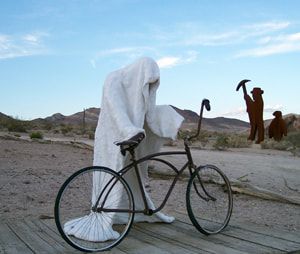|
Looking for some ghostly fun this October that allows for social distancing? Visit a ghost town! If you also have an interest in gold mining history, so much the better. It is estimated that about 3,800 ghost towns are still standing across the USA, mostly out West. Some of the buildings are in great condition, others are quite literally falling down. Some towns have become well-known, easy-to-reach roadside attractions, others are quite remote. Each town has its own boom-to-bust story that makes a visit both interesting and educational. Whether you’re a ghost hunter or a history buff, please leave everything as you find it. Take lots of photos, but no souvenirs, and be sure to wear appropriate snake gaiters or hiking gaiters and a neck gaiter / face covering for extra protection in harsh climates and conditions.  Rhyolite, Nevada. Winding throughout the rich and colorful Silver State, Nevada’s highways and byways are ideal for discovering America’s history. Route 374 is a prime example and leads to the much-photographed ghost town of Rhyolite. As far as boomtowns go, Rhyolite is a “newer” ghost town, having been born and busted between 1904 and 1920. What’s also special is that its crumbling yet photogenic buildings are mostly made of concrete, not wood. Since lumber was scarce in the desert, one creative miner even built his home out of mud and 30,000 assorted liquor bottles! But perhaps what is most unusual here is that you are guaranteed to see ghosts as you head into Rhyolite— yes, even in broad daylight! That’s because on the same gravel road heading toward Rhyolite, you’ll find a 15-acre outdoor sculpture park— Goldwell Open Air Museum. Among the unusual pieces of art are life-size ghosts, a 25-foot high pink woman made of cinder blocks, a 24-foot high steel prospector posing with a penguin, and much more. More about Rhyolite here.  Bannack State Park, Montana. Although the old-time prospectors are long gone, many mining relics and over 60 buildings remain in Bannack State Park. Most are so well preserved that you can actually go inside them— a rare treat when it comes to ghost gowns. Bannack’s rich history began 150 years ago with John White’s discovery of placer gold along the banks of Grasshopper Creek. In July 1862, Mr. White filed one of the first recorded mining claims in what was later to become the state of Montana. Good news traveled fast and by fall of that year, “Grasshoper Diggins” was home to 400 prospectors. By the following spring, the population had swelled to 3,000 — the Gold Rush was definitely on! On the southeast end of Bannack, the Bessette House is believed to be haunted by the children who died here during an epidemic of scarlet fever. The site is nicknamed the Crying Baby House because of the sounds some visitors have reported hearing. Visit the Bannack State Park website.  Bodie State Park, California. When a little girl writes in her diary “Goodbye God, I’m going to Bodie” you know her destination isn’t a pleasant one— not in the 1880s anyway when she penned that entry. The child’s name is unknown, but her words have became famous throughout the West to describe her family’s move to Bodie, California— once known as the Wildest Mining Camp in the West. Today, the lawlessness is long gone. Now a State Historic Park, Bodie is the nation's biggest unreconstructed ghost town, and provides an authentic look back into California’s mining history. What's left of Bodie—about 170 buildings and the Standard Mill— represents just five percent of what was standing in its 1870-1890 heydey. There are no re-creations or restorations here. Everything is officially in a state of "arrested decay," meaning only minimal repairs are made on the remaining structures. The weather is really unpredictable here, so consider having snow gaiters when you visit. More info on Bodie here. A trip to a ghost town might haunt you forever!Comments are closed.
|
RAZER GAITERS
 RSS Feed
RSS Feed
